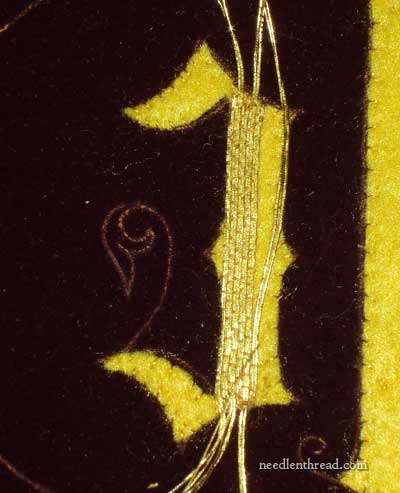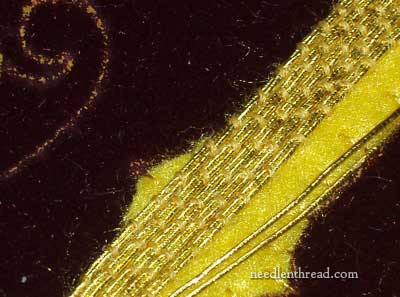I love gold passing thread! I’ve said it before, and I’ll probably say it again! It always looks nice, no matter how it’s used. It’s just a great metal thread.

But I don’t like taking photos of velvet. Out of 58 photos, I had two shots that were decent enough to use. This particular fabric is Extremely Reflective Stuff, even though from afar, it just looks dark and a little plush.
Anyway, back to passing thread! On this project, I’m using #5 gold smooth passing thread – non-tarnish variety. It’s available through any place that carries needlework supplies from Access Commodities.

To couch the gold, the thread is a 50 wt Tire silk, waxed with beeswax.
Those lines of gold represent exactly 1 hour and 15 minutes of work. I don’t generally time everything I do, but with this project, time is a point of curiosity for me.
Any tips for getting good photos of velvet? I’m all ears if you’ve got any!
Enjoy your Friday!







Goldwork on velvet – how gorgous is that!
I’ve not done any embroidery on velvet, which is surprising because I adore it. So I have not photographed velvet but I have photographed many other shiney materials like silk and beads. In my experience, the important thing is the light. I prefer natural day light on a lightly overcast day and fortunately we get a lot of those in England. If I have to photograph something on a brightly sunny day, I find a spot close to a window not in direct sunlight so I get a nice defused light. On a very dull day, I just have to wait or accept a bad picture 🙁
Thanks, Carol-Anne – I appreciate those tips! I think I tend to overdo light when I’m photographing anything (big time!), but today, we do have a cloudy day, so I’ll try natural “cloudy” light to see how that works. Of course… it’s raining… so that might not be a good idea at the moment! But I am going to try it and see how it goes! Thanks heaps! ~MC
Hi Mary,
You can try using pieces of tracing paper to shield your flash and lights. This creates a nice diffused light and can help reduce reflections.
If the lights are too big for tracing paper a light weight white fabric can work too.
No matter what you use, watch out for the heat of the lights against the shield materials.
Hi, Cheryl – thanks for the tip on the lighting. I finally invested in a “real” studio (as in, photography) lighting set-up, for video, and I’ve that it works great with photos, too. So I’ve been stitching in the midst of these rather large things that look like pillows on the front (light tents, on stands, with baffles and so forth), and it’s kind of nice! The lighting is terrific. But they take up So Much Room! Still, it’s been good for video, and for still shots, so next time I snap photos of the velvet piece, I’ll try it there, too. Thanks a bunch! ~MC
Hi Mary. Lovely work – as ever!
Do you ever cover your felt with organza to prevent the ‘hairiness’?
HI, Jacqui – Thanks for the tip. I never thought of covering the felt. I’ve used organza over velvet, but hadn’t thought about it for the felt. This felt is exceptionally fuzzy, partially because of the way I transferred the design (dumb of me – I used freezer paper, but it got too stuck and then I peeled it off, and that really made the felt fuzzy) and partially because it’s “craft” felt, as opposed to good wool felt. Normally, I use wool felt, and there’s very little fuzz with that. Live and learn! The fuzz is extra noticeable in the photos, because they’re taken pretty up close. It isn’t so bad in person – well, at least it isn’t AS noticeable! 🙂
I have done some photography of framed-under-glass paintings…and everyone is correct about the lighting..to avoid glare there is supposed to be even lighting from all sides–having the photog studio will be a big help! Love your tutorials…
Beautiful stitching. I, too, love velvet but have never thought of stitching on it, either.
I’m an amateur photographer, also, and one thing I’d suggest is investing in a couple of lens if your camera can take them: a polarizing one and/or a neutral density filter. If these aren’t possible and your camera allows it, a hood should help.
Keep up the great work!
The velvet reminded me of something I used to really love to do (but haven’t for a while). When punch needle came out (I think I am talking ‘early ’80’s’ here), I liked to do it on velvet using 6 strands of floss — and then trim the loops down to the height of the pile of the velvet — so it looked like a custom designed piece of velvet (velveteen worked, too) instead of “needlework”…. very subtle and very ‘one of a kind’…
Velvet is a napped fabric, so it has a very different appearance if you turn it upside down. Even the shiniest velvet may turn dense and light absorbing when viewed “against the grain”. Before you try adjusting your photo setup, I would try turning your work upside down — then re-adjust it by rotating the image for upload. Hope that will be all the help you need!
Thanks for sharing this! Do be sure to share the finished piece. Is it perhaps an Ecclesiastical design of IHS? You keep encouraging, and one of these days I’ll be bold enough (and have the funds) to try real goldwork. When real metal threads won’t fit the budget, can one use metallic threads and couch those? Just curious if anyone has tired this.
Hi Mary,
I’m interested to know if there are follow-on articles from this particular pieces of emblem on velvet. It is the same design I’m wishing to use, and am interested to know what you did for the line between the raised/filled areas in the first photo. What type of gold thread was used and was it also couched down? Thank you in advance.
Here’s the conclusion of that project: https://needlenthread.wpengine.com/2014/07/home-again-finished-ecclesiastical-goldwork-embroidery.html All the threads are couched thread. Check thread (not check purl, but wavy check thread that’s couched) was used around the letters and working the filigree. The frame was outlined with a fine twisted gold thread.
Thanks very much Mary for the link to the finished project, and what threads were used. Very much appreciated.
algun día lo hare ,,,gracias Mary